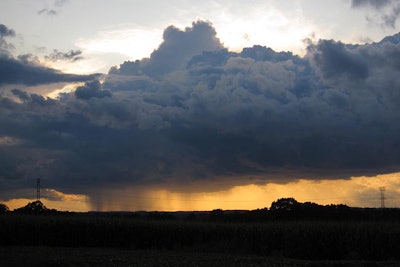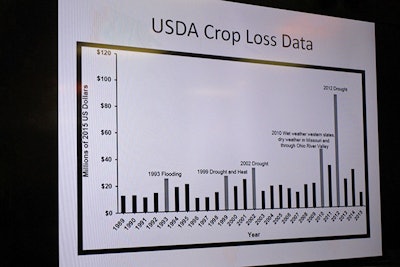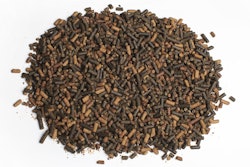
Climate change poses unprecedented challenges to U.S. agriculture because of the sensitivity of agricultural productivity, explained Dennis Todey, a climatologist and professor at South Dakota State University who currently directs the activities of the United States Department of Agriculture (USDA) Midwest Climate Hub. “We have a change in climate. It is changing what we’re able to do and where we’re able to do it, and we’re not changing how we’re adapting to it fast enough,” he continued.
Todey outlined climate changes currently impacting agriculture and what to expect during the upcoming growing season during a presentation at the Midwest Organic and Sustainable Education Service (MOSES) Organic Farming Conference in La Crosse, Wisconsin, on February 25, 2017.
Weather and climate patterns are a driving force behind the success or failure of Corn Belt cropping systems. Recent data show an increase in climate variability, an increase in the number and intensity of extreme events, and changing trends in climate and weather. “Because of these changes, there has been more crop loss data,” says Todey. Other implications include changing typical growing zones and expanding the Corn Belt into areas with potentially more risk of crop failure.

Recent data show an increase in climate variability, an increase in the number and intensity of extreme events, and changing trends in climate and weather, presented Dennis Todey at the 2017 MOSES Organic Farming Conference.
Climate changes currently impacting agriculture
One of the major changes in climate, said Todey, is the shift in seasonality in precipitation, with more intense precipitation in the spring and reduced amounts later in the summer.
We’re getting wetter. The entire Corn Belt has seen increased precipitation in bigger events over the last 100 years, with the most change in the last few decades. “Is that good? Is that bad?” asked Todey. “It’s both. If we have more rainfall at exactly the right times, that would be just perfect. But unfortunately, that’s not the way it is; we’re getting rainfall at different times.”
These shifts in seasonality and intensity need to be understood relative to current cropping systems and conservation practices.
Midwestern agriculture is dominated by rain-fed agricultural systems, said Todey, and crop production is determined by the amount of rain that occurs during the growing season and is stored in the soil profile. The trend towards fewer workable field days due to the shifting precipitation amounts affects the planning operations for producers to establish their crops.
The upper Midwest region has seen a 15 percent increase in water occurring in bigger events, with most of the rest of the region receiving 10 percent more rainfall, according to USDA data presented by Todey. North Central Ohio received 15 inches of rain last September. More water to deal with means saturated soils, water quality issues, more runoff and nutrient loss. Extreme events, such as floods, can cause erosion and damage to fields.
We’re getting warmer. The Corn Belt is also getting warmer, with fewer colder nights, higher and highly variable average winter temperatures, and more frost-free periods. “The further north you are and the further west you are the places where we’ve seen the biggest changes,” said Todey. “Data show an average of an additional nine frost-free days and up to 20 days in places like South Dakota.”
Issues with warmer temperatures include plants breaking dormancy earlier, the possibility for more insect pest cycles, more weeds, and potential changes in timing and coincidence of pollinator lifecycles. Plus, the increasing moisture in the atmosphere results in complicated issues such as changing disease potential and added stress to both people and livestock. Todey added that the Eastern two-thirds of the country are seeing record high dew points.
These shifts in seasonality and intensity need to be understood relative to current cropping systems and conservation practices, said Todey.
The 2017 growing season
Very warm late winter temperatures are quickly melting snow, warming soils and pushing perennials to break dormancy across the Midwest, according to National Oceanic and Atmospheric Administration (NOAA) outlooks and USDA Climate Hub data presented by Todey.
Precipitation is wetter than average across the Northern Plains in March and all the Northern Plains to Great Lakes for the March to May period. Parts of North Dakota and Minnesota are likely to still be wet from melting snow. Other parts of the region — Northern Iowa, Southern Minnesota and Western Wisconsin — are wet as a carry-over from fall 2016 precipitation. Review of local soil conditions and consideration of above average precipitation on spring planting should be strongly considered in northern areas.
In the area from Missouri, Southern Iowa and Illinois, the opposite issue is being closely watched. Late fall dryness with limited winter precipitation has left fairly dry soils. Current outlooks do not expect drought conditions there to develop because of usual spring precipitation. But if rains should fail to appear, drought will develop more quickly. Spring planting delays are expected to be limited here.
Todey added that La Niña is disappearing, and both La Niña and El Niño are not going to be major players in weather patterns this year. There is a small possibility for El Niño to play a part by late summer, which climatologists are watching.
The trend for March, April and May in the spring of 2017 is trending warmer for most of the country. Two computer model summaries have been hinting at a dryer summer. “Don’t bet the bank on that, but keep it in the back of your mind,” said Todey.
Responding to climate change
Todey encourages produers to visit the USDA Climate Hubs, which aim to better prepare farmers with adaptive responses to climate change by working with them to deliver science-based, region-specific information and technologies to enable climate-smart decision making.
Todey also recommends that producers use Useful to Usable (U2U), an integrated research and extension project working to improve farm resilience and profitability in the North Central U.S. by transforming existing climate data into usable products for the agricultural community.
"I can't tell you about the policy. But I can tell you about the science, and I can help you make decisions."
The U.S. Drought Monitor is also a valuable resource with new maps drawn every week. NOAA also releases daily and monthly outlook climate predictions, which Todey recommends producers check out, if they don’t already.
As for the climate change policy, Todey said, "I can't tell you about the policy. But I can tell you about the science, and I can help you make decisions."













